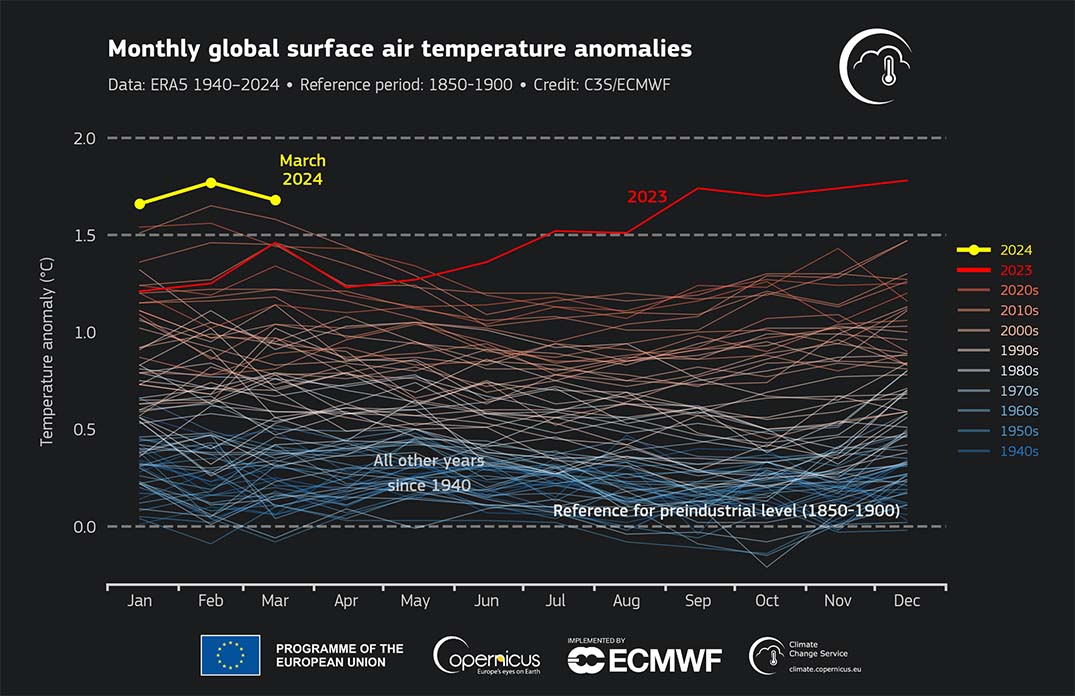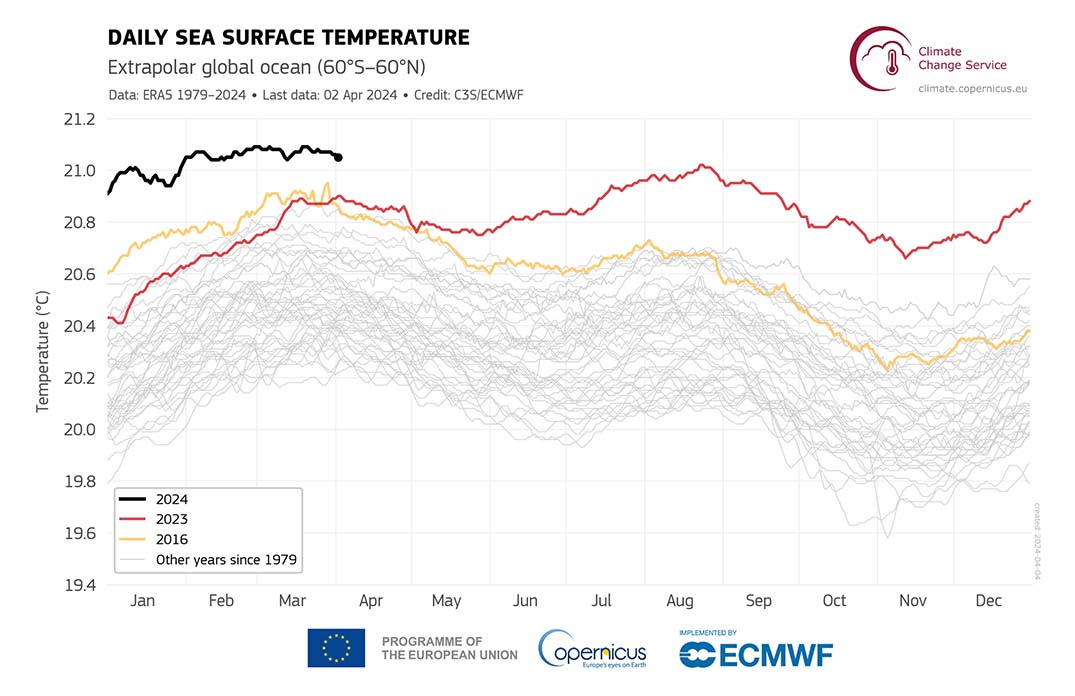Global record-breaking heat continues as March 2024 has come in as the hottest month on record – making it the 10th in a row.
The Copernicus Climate Change Service (C3S), implemented by the European Centre for Medium-Range Weather Forecasts on behalf of the European Commission with funding from the EU, routinely publishes monthly climate bulletins reporting on the changes observed in global surface air and sea temperatures, sea ice cover and hydrological variables.
All the reported findings are based on computer-generated analyses and according to ERA5 dataset, using billions of measurements from satellites, ships, aircraft and weather stations around the world.

Monthly global surface air temperature anomalies (°C) relative to 1850–1900 from January 1940 to March 2024, plotted as time series for each year. 2024 is shown with a thick yellow line, 2023 with a thick red line, and all other years with thin lines shaded according to the decade, from blue (1940s) to brick red (2020s). Data source: ERA5. Credit: C3S/ECMWF
Surface air temperature and sea surface temperature highlights include:
- March 2024 was warmer globally than any previous March in the data record, with an average ERA5 surface air temperature of 14,14°C, 0,73°C above the 1991-2020 average for March and 0,10°C above the previous high set in March 2016.
- This is the 10th month in a row that is the warmest on record for the respective month of the year.
- The month was 1,68°C warmer than an estimate of the March average for 1850-1900, the designated pre-industrial reference period.
- The global-average temperature for the past twelve months (April 2023 – March 2024) is the highest on record, at 0.70°C above the 1991-2020 average and 1.58°C above the 1850-1900 pre-industrial average.
- The average European temperature for March 2024 was 2,12°C above the 1991-2020 average for March, making the month the second warmest March on record for the continent, only a marginal 0,02°C cooler than March 2014. Temperatures were most above average in central and eastern regions.
- Outside Europe, temperatures were most above average over eastern North America, Greenland, eastern Russia, Central America, parts of South America, many parts of Africa, southern Australia, and parts of Antarctica.
- The El Niño continued to weaken in the eastern equatorial Pacific, but marine air temperatures in general remained at an unusually high level.
- The global sea surface temperature averaged for March over 60°S–60°N was 21,07°C, the highest monthly value on record, marginally above the 21,06°C recorded for February.
Samantha Burgess, deputy director of Copernicus Climate Service (C3S), emphasised the significance of the situation: “March 2024 continues the sequence of climate records toppling for both air temperature and ocean surface temperatures, with the 10th consecutive record-breaking month.
“The global average temperature is the highest on record, with the past 12 months being 1,58°C above pre-industrial levels. Stopping further warming requires rapid reductions in greenhouse gas emissions.’’

Daily sea surface temperature (°C) averaged over the extra-polar global ocean (60°S–60°N) for 2016 (yellow), 2023 (red), and 2024 (black line). All other years between 1979 and 2022 are shown with grey lines. Data source: ERA5. Credit: Copernicus Climate Change Service/ECMWF

Daily sea surface temperature (°C) averaged over the extra-polar global ocean (60°S–60°N) for 2016 (yellow), 2023 (red), and 2024 (black line). All other years between 1979 and 2022 are shown with grey lines. Data source: ERA5. Credit: Copernicus Climate Change Service/ECMWF
Sea ice highlights include:
- Arctic sea ice extent reached its annual maximum in March, with a monthly value slightly below average, marking the highest March extent since 2013.
- As in January and February, sea ice concentration anomalies were mixed across the Arctic Ocean. Concentrations remained above average in the Greenland Sea, a persistent feature since October.
- Antarctic sea ice extent was 20% below average, the sixth lowest extent for March in the satellite data record, continuing a series of large negative anomalies observed since 2017.
- As in February, sea ice concentrations were most below-average in the northern Weddell Sea and in the Ross-Amundsen Sea sector.
Hydrological variables highlights include:
- In March 2024, it was wetter than average in most of western Europe, with storms causing heavy rainfall over the Iberian Peninsula and southern France. It was also wetter than average in regions of Scandinavia and north-western Russia.
- The rest of Europe was predominantly drier than average, with pronounced below-average precipitation over north-western Norway.
- In March 2024, it was wetter than average in regions of North America, across Central Asia, Japan, much of the Arabian Peninsula, Madagascar, and parts of South America. Australia experienced an exceptionally wet month.
- Drier-than-average conditions established in parts of central USA, western Canada and northern Mexico, regions of Central Asia and China and in south-eastern Australia, most of southern Africa and South America.
Featured picture: Surface air temperature anomaly for March 2024 relative to the March average for the period 1991-2020.
Data source: ERA5. Credit: Copernicus Climate Change Service/ECMWF

